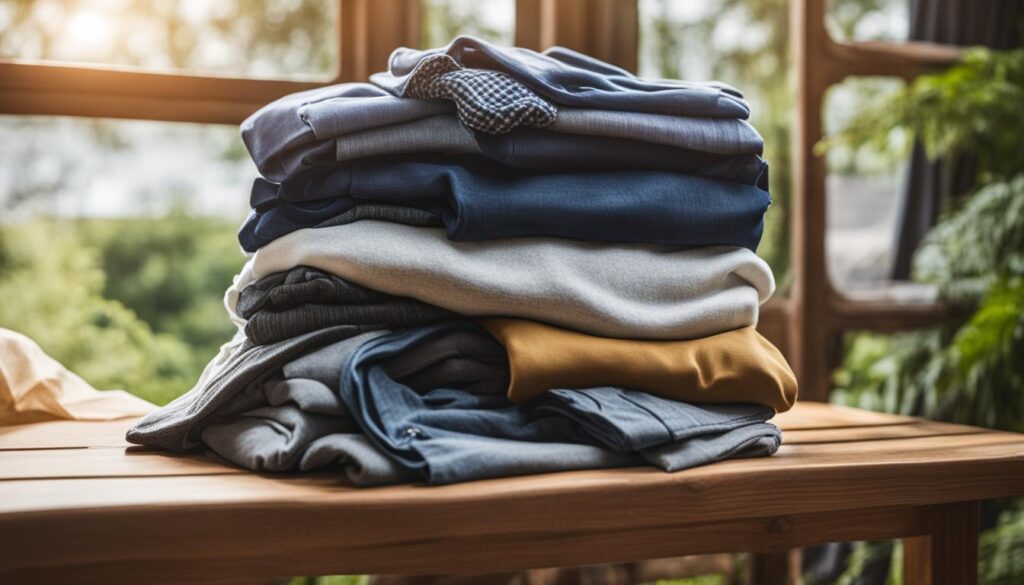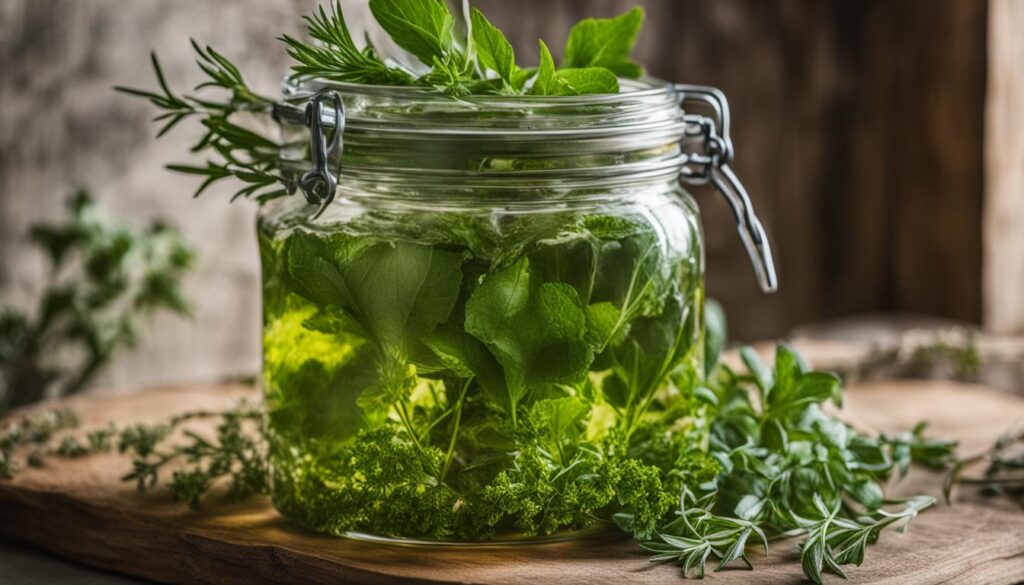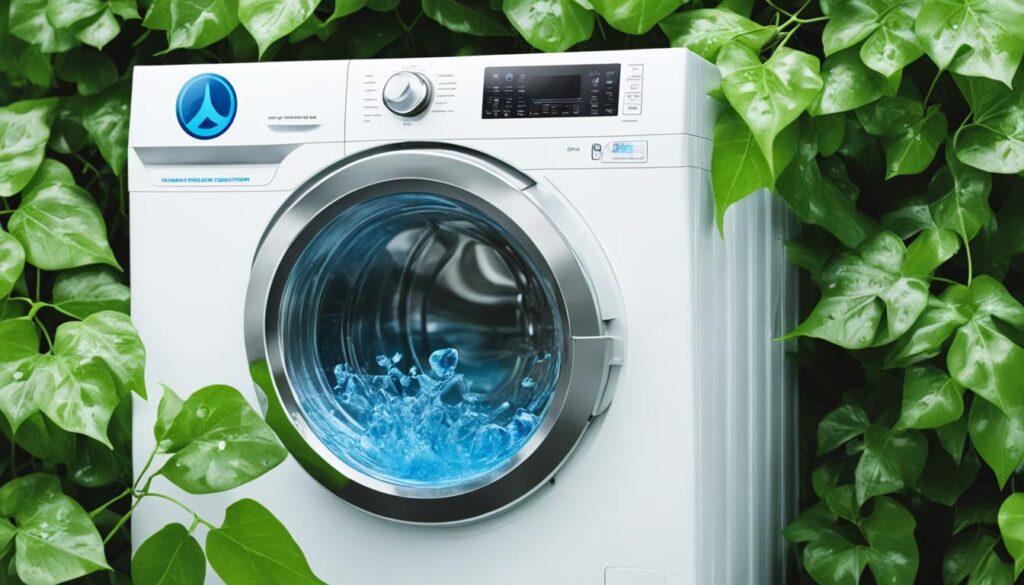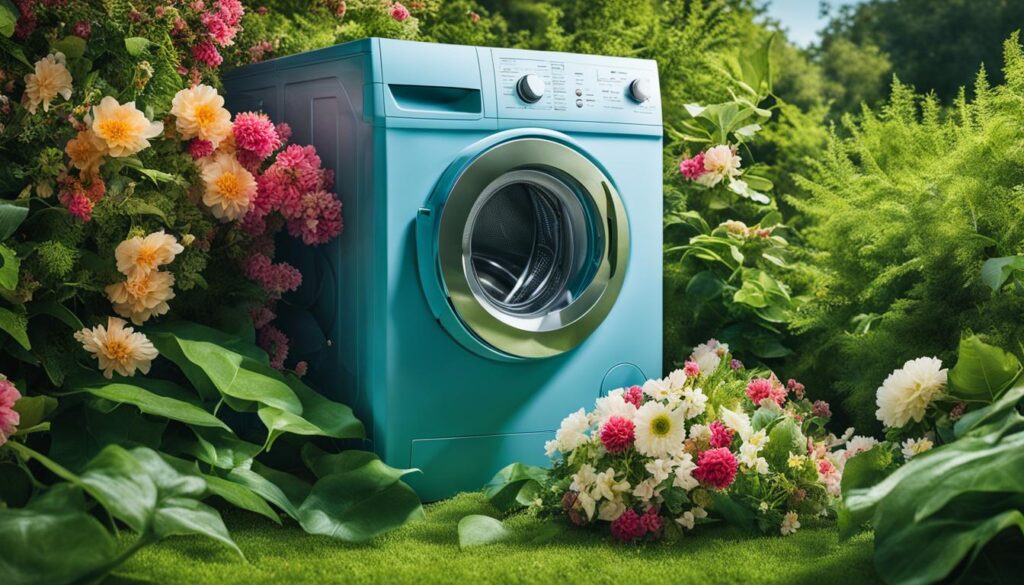Welcome to our guide on eco-friendly laundry solutions for a greener home. Taking steps to make your laundry routine more sustainable can have a significant impact on the environment. By implementing these tips and hacks, you can reduce your carbon footprint and contribute to a healthier planet.
Key Takeaways:
- Choose green laundry products for a more eco-friendly approach to laundry.
- Explore sustainable and environmentally-friendly laundry solutions.
- Consider natural laundry products as alternatives to traditional detergents.
- Opt for green laundry alternatives that prioritize organic materials.
- Make eco-conscious choices in packaging and choosing green laundry solutions.
The Environmental Impact of Traditional Laundry Practices
Traditional laundry practices have a significant environmental impact, contributing to various issues that harm our planet. From the carbon footprint generated by laundry processes to excessive cleaning that results in clothes ending up in landfills prematurely, and the plastic waste generated by detergent packaging, these practices take a toll on our environment. Additionally, the shedding of microfibers from synthetic clothes during washing contributes to microfiber pollution, which not only harms the environment but also poses a threat to human health.
It is crucial to understand the environmental consequences of our laundry habits and seek alternatives that are more sustainable and eco-friendly. By making informed choices, we can reduce our carbon footprint, minimize plastic waste, and mitigate the impact of microfiber pollution on our planet.
“The shedding of microfibers from synthetic clothes during washing contributes to microfiber pollution, which not only harms the environment but also poses a threat to human health.”
Reduce Frequency of Laundry

One simple way to make your laundry routine more eco-friendly and sustainable is to launder less often. While it’s important to wash underwear and socks after each use, there are many items in your wardrobe that can be worn multiple times before needing a wash, such as jeans, jackets, and pullovers.
For example, instead of washing your jeans every two wears, try washing them after every ten wears. This small change can significantly reduce energy use and the overall environmental impact of your laundry routine. By reducing the frequency of washing, you not only save water and energy but also extend the lifespan of your garments.
Not only is laundering less often beneficial for the environment, but it also saves your time and money. You’ll spend less time doing laundry and lower your water and electricity bills.
Remember, when it comes to eco-friendly laundry, less is more. Embrace the idea of wearing your clothes multiple times before tossing them in the hamper, and you’ll contribute to a greener home and a healthier planet.
Key points:
- Wash underwear and socks after each use, but consider wearing other items multiple times before washing.
- Reducing the frequency of washing can significantly reduce energy use and the overall environmental impact.
- Laundering less often saves time, money, and extends the lifespan of your garments.
“By washing your jeans after every ten wears instead of every two, you can significantly reduce energy use and the overall environmental impact.”
Plastic-Free and Low-Impact Packaging Options
Traditional laundry detergents often come in plastic jugs, which contribute to plastic waste. To reduce your environmental impact, there are several plastic-free and low-impact packaging options available:
1. Refillable Bottles: Consider buying a sturdy plastic jug once and then refilling it at zero-waste stores that offer liquid detergent refill stations. This way, you can significantly reduce plastic waste by avoiding single-use detergent containers.
2. Compostable Bags: Another eco-friendly option is to choose laundry detergents that come in compostable bags. These bags are made from plant-based materials and break down naturally over time, minimizing their environmental impact.
3. Dissolvable Packaging: Some innovative laundry detergent brands now offer dissolvable packaging options. These dissolvable pods dissolve completely in the wash, eliminating the need for plastic packaging. They are often made from biodegradable materials, making them a sustainable alternative.
By opting for plastic-free and low-impact packaging options, you can contribute to reducing plastic waste and promoting a greener laundry routine.
Comparison of Plastic-Free and Low-Impact Packaging Options
| Packaging Option | Advantages |
|---|---|
| Refillable Bottles | – Reduces plastic waste – Can be refilled multiple times – Convenient for zero-waste shopping |
| Compostable Bags | – Made from plant-based materials – Breaks down naturally – Reduces plastic pollution |
| Dissolvable Packaging | – Dissolves completely in the wash – Biodegradable materials – Eliminates plastic waste |
“By opting for plastic-free and low-impact packaging options, you can contribute to reducing plastic waste and promoting a greener laundry routine.”
Vinegar and Soap Nuts as Natural Alternatives

Looking for natural and chemical-free alternatives for your laundry? Consider using household vinegar and soap nuts. These eco-friendly options are not only effective but also gentle on the environment and your skin. Here’s how you can incorporate them into your laundry routine:
Vinegar: A Natural Cleaning Agent
Vinegar is a versatile household ingredient that can be used for various cleaning purposes, including laundry. Simply pour a half cup of distilled white vinegar into the washing machine instead of traditional detergent or fabric softener.
Vinegar acts as a natural cleaning agent, removing dirt, odors, and buildup from your clothes. It helps brighten colors, soften fabrics, and eliminate static. Additionally, vinegar can help remove stubborn stains and prevent colors from bleeding.
When using vinegar, it’s important to note:
- Use distilled white vinegar to avoid discoloration.
- Do not use vinegar with bleach or hydrogen peroxide, as it can create harmful fumes.
- If you’re concerned about the strong smell, don’t worry—the vinegar scent evaporates during the rinse cycle, leaving your clothes fresh and odor-free.
Soap Nuts: Nature’s Own Laundry Detergent
Soap nuts are the dried shells of berries from a tree native to the Himalayas. These natural wonders contain saponins, a soap-like chemical that produces a foamy cleaning agent when agitated in warm water.
To use soap nuts in your laundry:
- Place 4-6 soap nuts in a cotton bag or sock.
- Tie the bag or sock securely and add it to your washing machine with your clothes.
- Select your desired cycle and wash as usual.
Soap nuts are an excellent alternative for those with sensitive skin or allergies, as they are hypoallergenic and free from harsh chemicals. They are also biodegradable, making them an eco-friendly choice.
Here’s a quick comparison between vinegar and soap nuts:
| Vinegar | Soap Nuts |
|---|---|
| Gentle on fabrics | Hypoallergenic |
| Removes odors | Effectively cleans clothes |
| Brightens colors | Biodegradable |
| Eliminates static | Gentle on the environment |
By incorporating vinegar and soap nuts into your laundry routine, you can achieve clean and fresh-smelling clothes while minimizing your environmental impact. Give these natural alternatives a try and experience the benefits of chemical-free cleaning.
Castile Soap for All-Natural Cleaning
When it comes to choosing a cleaning solution for your laundry, castile soap is an excellent option. Made from vegetable-based ingredients, castile soap is a natural and eco-friendly alternative to chemical-laden detergents. Not only does it effectively remove dirt and stains, but it is also gentle on both your skin and fabrics.
Unlike traditional detergents that may contain harsh chemicals, castile soap is non-toxic and safe to use. Its all-natural formulation makes it an ideal choice for individuals with sensitive skin or allergies. You can trust that castile soap will be kind to your skin and won’t cause any irritation or discomfort.
Moreover, castile soap is biodegradable, which means it won’t harm the environment when it goes down the drain. It breaks down into harmless substances, reducing the risk of pollution and preserving our ecosystems.
If you’re looking to take your eco-friendly laundry routine to the next level, consider making your own castile soap at home. There are numerous recipes available online that allow you to customize the soap to your liking while eliminating any unnecessary additives or chemicals. By making your own soap, you have complete control over the ingredients and can ensure that it aligns with your values of sustainability and non-toxicity.
“Castile soap is a versatile and effective option for all-natural cleaning. Its plant-based formula provides powerful cleaning action without compromising on gentleness. Whether you’re washing your delicates or your baby’s clothes, castile soap is a reliable choice that you can feel good about.”
The Benefits of Castile Soap:
- Gentle on both skin and fabrics
- Non-toxic and safe for sensitive individuals
- Biodegradable and environmentally friendly
- Customizable when making it at home
With its many benefits and sustainable qualities, castile soap is a smart and conscious choice for a greener laundry routine.
Castile soap is a versatile and eco-friendly option that leaves your clothes refreshed and clean, without any harsh chemicals or toxins. Give it a try and experience the difference it can make for both your laundry and the environment.
Choosing Between Powder and Liquid Detergents
When it comes to selecting the right detergent for your laundry, it’s important to consider the environmental impact. Both powder and liquid detergents have their pros and cons, but opting for a natural and sustainably produced option is the way to go.
If you prefer liquid detergents, look for brands that offer refillable options. Zero-waste stores often have refill stations where you can replenish your liquid detergent, reducing the need for new plastic packaging. This sustainable choice not only minimizes waste but also promotes a greener laundry routine.
However, if you prefer the convenience of powder detergent, choose a natural variety that is packaged in cardboard. Cardboard packaging is easier to recycle compared to plastic containers commonly used for powder detergents. By opting for a natural powder detergent in recyclable packaging, you can still ensure a more environmentally friendly laundry routine.
Ultimately, the choice between powder and liquid detergents depends on your personal preference and lifestyle. Consider your priorities in terms of environmental impact and convenience as you make a decision that aligns with your values.
| Option | Pros | Cons |
|---|---|---|
| Liquid Detergents | Refillable options available | May come in plastic packaging |
| Powder Detergents | Packaged in recyclable cardboard | May be less convenient to use |
The Benefits of Washing Clothes in Cold Water

Did you know that washing your clothes in cold water can make a significant difference in both energy savings and fabric preservation? According to researchers at Harvard University, washing clothes in cold water is just as effective as using hot water for everyday loads. Let’s explore the benefits of this eco-friendly laundry practice.
Energy Savings
One of the main advantages of cold water washing is the energy savings it offers. Heating water accounts for a significant portion of the energy used during the laundry process. By opting for cold water, you can reduce the need to heat water and conserve energy. According to the U.S. Department of Energy, washing clothes in cold water can save up to 90% of the energy used for hot water washing.
Fabric Preservation
Hot water can be harsh on fabrics, leading to color fading, shrinking, and weakening of fibers over time. Cold water washing is gentler, helping to preserve the integrity and longevity of your clothes. By washing in cold water, you can extend the lifespan of your favorite garments and reduce the need for frequent replacements, ultimately saving money.
Stain Removal
Cold water washing is not only effective in preserving fabrics but also in removing stains. Contrary to popular belief, cold water can effectively remove everyday stains, including dirt, food, and sweat. Cold water prevents stains from setting, making them easier to eliminate during the washing process.
By making the switch to cold water washing, you can enjoy the benefits of energy savings, fabric preservation, and effective stain removal. Not only does it contribute to a greener home and a reduced carbon footprint, but it is also a wallet-friendly choice. So, next time you do your laundry, consider using cold water and reap the rewards!
| Advantages of Cold Water Washing | Benefits |
|---|---|
| Energy Savings | Reduces the need for heating water, saving energy |
| Fabric Preservation | Gentler on fabrics, extends their lifespan |
| Stain Removal | Effectively removes everyday stains |
Maximizing Efficiency with Proper Load Sizes
One effective way to maximize efficiency and reduce the release of microfibers during the laundry process is to ensure that your washing machine is filled to the recommended capacity, which is usually three-quarters full. By doing so, you can optimize the water-to-fabric ratio, resulting in cleaner and more efficient wash cycles.
If you find it challenging to fill your washing machine to the recommended capacity, you can utilize the load size selector option, if available. This feature allows you to match the water levels with the load size, ensuring that you use the appropriate amount of water for each cycle.
Larger loads have been shown to decrease the release of microfibers due to the lower water-to-fabric ratio. By filling your washing machine with larger loads, you can effectively minimize the impact of microfiber pollution on the environment and promote a more sustainable laundry routine.
| Advantages | Recommendations |
|---|---|
| Maximizes efficiency | Fill the washing machine to the recommended capacity or utilize load size selector if available |
| Reduces release of microfibers | Opt for larger loads to achieve a lower water-to-fabric ratio |
By following these recommendations, you can ensure that your laundry routine is not only efficient but also eco-friendly, contributing to the overall well-being of the planet.
Protecting the Environment with Microfiber Filters
Microfiber pollution poses a significant threat to the environment. The shedding of microfibers from synthetic clothes during the washing process contributes to this pollution. These tiny particles find their way into wastewater, eventually contaminating oceans and soils. However, there is a simple and effective solution to combat this issue – the Planet Care filter.
The Planet Care filter has been thoroughly tested and proven to capture approximately 90 percent of microfibers, preventing them from entering the wastewater system. By installing a microfiber filter in your washing machine, you can actively contribute to controlling microfiber pollution and protecting the planet.
Installing a microfiber filter is a straightforward process. It works by capturing the microfibers released during the washing cycle and preventing them from entering the water supply. This filter acts as a barrier, capturing and trapping the tiny particles, and ensuring they do not pollute the environment.
In addition to its effective filtration capabilities, the Planet Care filter is compatible with a wide range of washing machines and does not interfere with the washing performance. It is a practical and sustainable solution to combat microfiber pollution.
By implementing the Planet Care filter, individuals can actively contribute to reducing the release of microfibers into the environment. Through this simple and effective solution, we can collectively work towards a cleaner and greener future.
Energy-Saving Alternatives to Machine Drying
Machine drying clothes consumes a significant amount of energy. To save energy, consider utilizing the air-drying method as an eco-friendly alternative. Hanging your clothes on a clothesline or drying rack allows them to air-dry naturally without the need for electricity. This simple change in your laundry routine can make a big difference in reducing your carbon footprint and energy consumption.
If air-drying is not a feasible option for you, there are other energy-efficient alternatives to traditional machine drying. One such option is the use of heat-pump dryers. These innovative dryers utilize a heat-pump technology that recirculates and reuses heat during the drying process, resulting in significant energy savings compared to conventional dryers. By opting for a heat-pump dryer, you can dry your clothes efficiently while minimizing energy consumption and environmental impact.
Another effective method to save energy during drying is by using wool dryer balls. These natural and eco-friendly balls help reduce drying time by creating space between clothes, allowing hot air to circulate more efficiently. Additionally, they help prevent static electricity buildup in your laundry, making it easier to manage. By incorporating wool dryer balls into your laundry routine, you can not only save energy but also reduce the need for chemical-laden dryer sheets and fabric softeners.
Choose an energy-saving alternative that aligns with your needs and preferences, whether it’s air-drying, heat-pump dryers, or wool dryer balls. By adopting these eco-conscious practices, you can contribute to a greener and more sustainable home while still enjoying fresh and clean laundry.
The Energy and Water Savings of Front-Loading Washing Machines

Front-loading washing machines are a smart choice for environmentally conscious individuals looking to save energy and water. These machines offer significant advantages over top-loading models, making them a worthwhile investment for a greener home.
On average, front-loading washing machines use approximately 7500 liters less water per year compared to their top-loading counterparts. This substantial water savings is achieved through their innovative design and efficient water usage.
Front-loaders also employ faster spin cycles, which reduce the moisture content in clothes, resulting in shorter drying times. By spending less time in the dryer, you not only save energy but also contribute to prolonging the lifespan of your garments.
Although front-loading machines generally have a higher upfront cost, their long-term energy and water savings make them a sound investment. Their efficient performance and reduced resource consumption align with eco-friendly goals and help minimize your environmental impact.
Alternative Approaches to Dry Cleaning
Dry cleaning using harsh solvents like perchloroethylene (perc) can be harmful to both health and the environment. Fortunately, there are alternative approaches that are gentler on your clothes and the planet. Consider these eco-friendly alternatives:
1. Hand-washing Delicate Fabrics
For delicate fabrics that require special care, opt for hand-washing using mild, eco-friendly soap. Fill a basin or sink with lukewarm water, add a small amount of soap, and gently agitate the garment. Rinse thoroughly and lay flat to dry. Hand-washing preserves the integrity of delicate fabrics while reducing your reliance on traditional dry cleaning.
2. Special Bags for Machine Washing
If you prefer using your washing machine, invest in special bags designed for machine washing delicate items. These bags protect fragile fabrics by minimizing friction and preventing tangling or snagging. Simply place the garment inside the bag, zip it up securely, and launder as usual. This approach offers a convenient alternative to traditional dry cleaning for more durable garments.
3. Liquid Silicone and CO2 Cleaning
For stains or garments that require a deeper clean, consider liquid silicone and CO2 cleaning. Liquid silicone cleaning utilizes a gentle silicone-based solvent that effectively removes dirt and stains without the use of harsh chemicals. CO2 cleaning involves pressurized carbon dioxide, which dissolves and removes dirt. Both methods offer effective alternatives to traditional dry cleaning, while minimizing harm to both the environment and your health.
By adopting these alternative approaches to dry cleaning, you can reduce your exposure to harmful chemicals and contribute to a cleaner, greener future.
Using Laundry Water for Gardening
An innovative and sustainable approach to laundry water is to collect it for gardening purposes. By recycling and reusing greywater from your laundry, you can contribute to sustainable living and reduce water waste.
Greywater recycling involves using the water from washing machines to water plants and gardens. This water, which would otherwise be directed to the wastewater system, can be manually bucketed and repurposed for gardening.
To ensure that the greywater is safe for plants, it is essential to use chemical-free detergents. These detergents are free from harmful chemicals and are gentle on both your clothes and the environment.
In addition to using chemical-free detergents, it is advisable to install a greywater filter to capture lint and impurities. This filter helps ensure that only clean water reaches your plants, while the lint and other particles are retained for easy disposal.
Once collected, the greywater can be used to water your garden or plants, providing them with much-needed hydration and reducing the demand for freshwater resources.
By implementing this greywater recycling system, you not only minimize water waste but also promote sustainable living by making the most efficient use of available resources.
The Top 10 Non-Toxic Laundry Detergents
When it comes to selecting laundry detergents, prioritizing effectiveness and environmental sustainability is essential. Luckily, there are several non-toxic options available on the market that offer both. These eco-friendly brands provide sustainable alternatives, made from natural ingredients and packaging that is kind to the planet. By choosing these non-toxic laundry detergents, you can switch to a greener laundry routine without compromising on cleanliness.
| Brand | Description | Certifications |
|---|---|---|
| Blueland | Blueland offers non-toxic laundry detergents in reusable packaging, reducing plastic waste. | Leaping Bunny, Cradle to Cradle |
| Attitude | Attitude’s eco-friendly laundry detergents are hypoallergenic and safe for the whole family. | EcoLogo, PETA Cruelty-Free |
| Grab Green | Grab Green provides non-toxic laundry detergents that are effective and free from harsh chemicals. | EPA Safer Choice, Leaping Bunny |
| Seventh Generation | Seventh Generation offers plant-based laundry detergents that are gentle on the skin and the environment. | EPA Safer Choice, Leaping Bunny |
| Tru Earth | Tru Earth offers laundry detergent strips that are convenient, eco-friendly, and effective. | Certified Biodegradable |
Image alt tag: non-toxic laundry detergents
These non-toxic laundry detergents prioritize sustainability by utilizing natural ingredients and reducing plastic waste. With certifications such as Leaping Bunny, EPA Safer Choice, and Cradle to Cradle, you can trust that these brands are committed to providing safe and eco-friendly options. By choosing non-toxic laundry detergents, you can contribute to a healthier planet while keeping your clothes clean and fresh.
Conclusion
By implementing these eco-friendly laundry solutions, you can make a significant difference in reducing your environmental impact and promoting a greener home. Small changes in your laundry routine can have far-reaching positive effects on the planet and contribute to a more sustainable future.
One of the key strategies is to reduce the frequency of laundry. Instead of washing clothes after every wear, consider wearing items like jeans, jackets, and pullovers multiple times before washing. This simple change can significantly reduce energy use and the overall environmental impact.
Choosing natural alternatives and sustainable packaging is another effective approach. Opt for vinegar or soap nuts as natural alternatives to traditional detergents. These options are chemical-free and eco-friendly. Additionally, consider using laundry detergent in refillable bottles, compostable bags, or solid bars to reduce plastic waste.
Washing clothes in cold water is not only energy-efficient but also helps preserve fabrics, prevent color bleeding, and remove stains effectively. By maximizing efficiency with proper load sizes and using microfiber filters, you can further minimize your impact on the environment.
In conclusion, by incorporating these eco-friendly laundry solutions into your routine and exploring non-toxic detergent options, you can make a positive and lasting impact on the planet. Let’s take small steps towards a greener future and contribute to a more sustainable world.
FAQ
How can I reduce my carbon footprint through my laundry routine?
Adopting eco-friendly laundry solutions, such as reducing the frequency of laundry, using natural alternatives, choosing sustainable packaging, and washing clothes in cold water, can significantly reduce your carbon footprint.
What are some plastic-free and low-impact packaging options for laundry detergents?
Consider buying laundry detergent in refillable plastic jugs or using laundry detergent in pre-measured paper strips, compostable bags, or solid bars to reduce plastic waste.
What are some natural alternatives to traditional laundry detergents?
Household vinegar can be used as a natural alternative to traditional detergents, as well as soap nuts, which contain saponins, a soap-like chemical that produces a foamy cleaning agent when agitated in warm water.
Are there any all-natural cleaning solutions for laundry?
Castile soap is an all-natural cleaning solution that is gentle on both skin and fabrics. It is non-toxic and can be made at home to eliminate the need for harmful chemical detergents.
What is the environmental impact of washing clothes in cold water?
Washing clothes in cold water can save energy by reducing the need to heat water, preserve fabrics, prevent color bleeding, and effectively remove stains.
How can I protect the environment from microfiber pollution caused by laundry?
Installing a microfiber filter, such as the Planet Care filter, can capture around 90 percent of microfibers, preventing them from entering wastewater and harming the environment.
What are some energy-saving alternatives to machine drying?
Air-drying your clothes on a clothesline or drying rack can save energy. Using heat-pump dryers and wool dryer balls are also more eco-friendly options.
How do front-loading washing machines contribute to energy and water savings?
Front-loading washing machines use around 7500 liters less water annually and have faster spin cycles, which reduces drying time for clothes, resulting in significant energy and water savings.
What are some alternative approaches to dry cleaning?
Hand-washing delicate fabrics with mild, eco-friendly soap, using special bags for machine washing, or using liquid silicone and CO2 cleaning are alternative approaches that are less harmful to health and the environment.
How can I use laundry water for gardening?
By using chemical-free detergents and a greywater filter to remove lint and impurities, you can collect laundry water and manually use it for watering plants, reducing water waste and promoting sustainable living.
What are some non-toxic laundry detergent brands available in the market?
Brands like Blueland, Attitude, Grab Green, Seventh Generation, and Tru Earth offer eco-friendly options made from natural ingredients, with sustainable packaging and certifications to ensure their non-toxicity.






